



Techno-fixes are big business. Taking a quick look over the Financial Times’ list of the world’s largest companies[1], it might not surprise us that five of the top spots are occupied by corporations dealing in Information Technology. The looseness of this term connotes the production and dissemination of hardware, software and data, yet increasingly such companies are moving beyond this operational remit and have begun selling a vision of how life in its totality could—and should—be lived. Over the last decade, these so-called ‘Big Tech’ companies—Apple, Alphabet (Google’s parent company), Microsoft, Amazon, and Facebook—have sought to fashion bespoke technological ‘fixes’ to particular global crises, with the aim being no less than shaping the future of humanity itself. Facebook’s Aquila solar drone project, for instance, will help four billion people in disparate regions of the globe ‘access all the opportunities of the internet’[2]. Meanwhile, Alphabet’s experimental X subsidiary is developing Project Loon, a competing network infrastructure powered by a fleet of solar balloons[3] .Which connected future do we want: one with networks of balloons or drones? Or, more to the point: one filtered through the prism of Google’s or Facebook’s algorithms? The fictional character of Gavin Belson, the deranged CEO of the quasi-Facebook-Google mashup Hooli in HBO’s comedy series Silicon Valley, captures the bizarre competitive logic of Big Tech utopianism when he states with marked frustration:

It is not only the digital divide and the contingent possibilities of market expansion which Big Tech is claiming to ‘solve’ with these ambitious infrastructural projects. Climate change, healthcare, forced migration, democracy, and automation are all staked out in branded promotional media[4] as challenges which have imminent technological solutions—just a few ‘versions’ away. In such media, we are pushed forward into a time where these complex issues have been resolved, becoming conspicuous non-features of everyday life, unrecognized background conditions that allow us to marvel at the much more spectacular and exciting business of glossy technological innovations: the familiar gesture-controlled sheets of glass, the smart-everythings and the augmented-anythings.
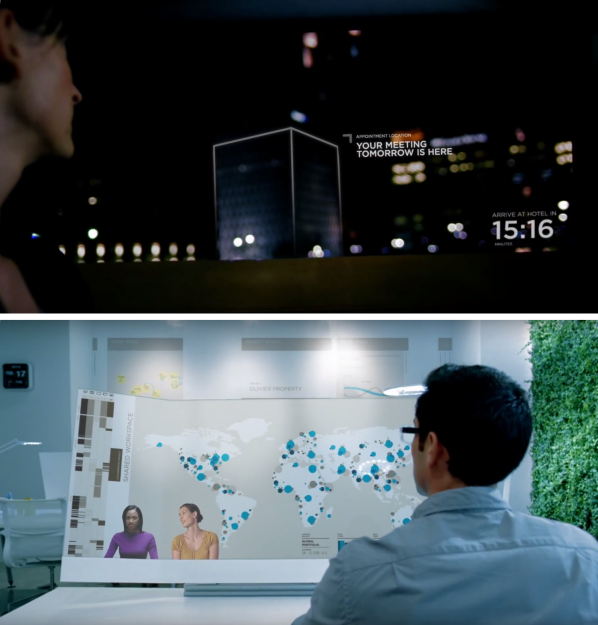
In these ‘design fictions’, as the Brazilian theorists Gonzatto et al. call such marketing campaigns, present crises ‘are anticipated and solved by technology’, proffering resolutions that ‘nurture consumers into consumption habits and convince investors of their capacity to fulfil those same demands’[5]. In this way, design fictions are replete with ‘solutionist’ fantasies where digital technology is positioned as a corrective to the challenges and irregularities of living. Solutionism, what Evgeny Morosov describes as an ‘intellectual pathology’[6] that can only consider problems in the form of their smart technical ‘fix’, nullifies any wider discussion of the problem at hand, abstracting the proposed resolution from the historical, social and political context of its implementation.
Therefore, whilst it is hard not to be seduced by the glossy ingenuity of projects such as Aquila and Loon, we ought to take a moment to question the frictionless future championed in these grand projects. The crises opened up and subsequently ‘solved’ by Big Tech companies scaffold the realm of present and future possibilities for our collective engagement: to determine a set of relations as constituting a crisis is to justify and arrange the ground for its resolution. For this reason, it is important to ask: Whose crisis is it anyway? Who has defined the problem that needs solving? And whose interests are being served by these proposed solutions? With such queries in mind, the benign qualities of design fictions are problematised, and their rootedness in the techno-politics of the present become plainly visible.

The recent publication of Mark Zuckerberg’s Building Global Community[7] manifesto affords such queries a timely focal point. At stake in Zuckerberg’s far-reaching manifesto is, in essence, the role that Big Tech can play in global governance. More specifically, it proposes the positive contribution that can come from Facebook’s direct engagement with the tasks of local and national security, the distribution and moderation of information, governmental politics, and fostering a post-national communalism.
These are indeed lofty ambitions, even for a company that boasts a quarter of the world’s population as monthly active users. However, Facebook purports to relish such a challenge, motivating employees by reminding them that the “journey is 1% finished”[8]. The ‘journey’ in question here is the fixing of what Facebook sees as a crisis of disconnection experienced by those almost exclusively situated in remote regions of the Global South. Facebook asks us to imagine how much better the lives of these ‘disconnected’ people could be if only they had access to the same degree of internet connectivity that those of us in the Global North enjoy on a day-to-day basis. With these sentiments in mind, the remainder of Facebook’s arduous voyage will largely be accomplished through the development of high-profile projects such as Internet.org, where the polished graphics of constituent programmes such as Free Basics and the aforementioned Aquila act as ethical avatars for Facebook’s very own brand of solutionism.
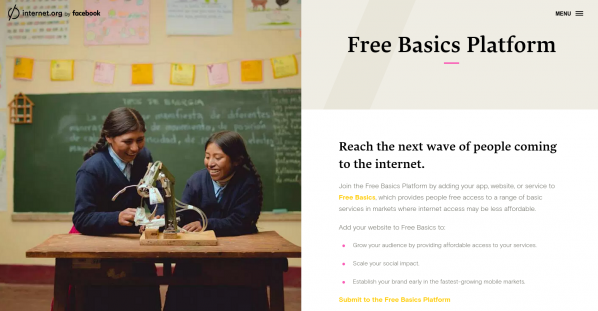
Zuckerberg claims that, ‘in times like these, the most important thing we at Facebook can do is develop the social infrastructure to give people the power to build a global community that works for all of us’[9]. Free Basics aims to provide a free-as-in-beer (but not free-as-in-freedom) curated portal to specific sites on the internet, providing information about healthcare, news, employment, and education to individuals who might otherwise live offline and thus disconnected lives. The humanitarian rhetoric follows that bringing ‘people online’ will ‘help improve their lives’ and additionally offer these societies ‘knowledge’, ‘tools’, and global connections—these are fundamentally good things worthy of our support, right? The predictable catch is revealed in Internet.org’s promotional material, whereby companies prospecting for new markets are offered a head-start on reaching ‘the next wave of people coming to the internet’[10], albeit through Facebook’s technical infrastructure and curatorial apparatuses. Such philanthropic endeavours, if successful, assist in consolidating the corporation’s present hegemonic position in future scenarios. For governments struggling with establishing network infrastructures, Free Basics proposes an attractively simple solution that, with Facebook’s capital and clout, can be quickly deployed and established. It is however a valuable foothold, one that prescribes a developmental course that entangles the technical apparatuses of the corporation with the task of future regional governance. This is the strategic-thinking which fuels the bizarre competitive logic of Big Tech utopianism, and which sits as the political kernel of future visions. It is the rhetoric of the real-life Gavin Belsons of Silicon Valley.
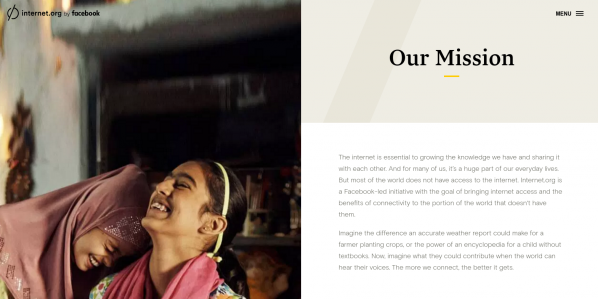
By determining that there is a crisis of disconnection, Facebook prepares the ground for its resolution in the form of projects such as Internet.org. The idea that a global community of connected Facebook users can level the systematic inequalities in wages, living standards, and welfare provision inherent to globalized capitalism is a resolution that erases the multiplicity of forces acting upon a complex array of interacting crises. In making this erasure, Facebook’s logic of development draws an uncomplicated line of progression from ‘unconnected’ to ‘connected’ subjects. Such thinking is as obviously reductionist, and contestable, as the pathways that lead from ‘boy’ to ‘man’, ‘young’ to ‘old’, ‘civilised’ to ‘uncivilised’. These binary terms edifying developmental logic are laden with normative significance, implying a way of thinking about the world that presupposes and prescribes a certain way of living within it. The interconnected and complex issues that contribute to global inequality—institutional structural biases, discriminatory trade relations, the experiences of colonialism, the exploitation of resources, to name but a scant few of a vast number—do not even come into the equation. In this schematic, Facebook’s own position in relation to these matters is unacknowledged. Furthermore, the position of humans as ‘Facebook users’ worldwide is not only rendered as neutral, closing off debate around value production and labour processes in digital capitalism, but positively imbued with some sort of higher moral purpose. What does it mean, then, for Facebook to imagine a time beyond crisis? To offer a resolution to the ‘problem’ of global disconnection? As Antoinette Rouvroy would argue, such thinking inoculates the present and ‘forecloses the future’[11].

This example of Internet.org does not simply aim to expose the economic incentives lurking behind such seemingly benevolent global projects—these motives should be obvious enough already. Rather, we hope to have opened up the conversation surrounding these future visions, and the possibility of techno-fixes in general, as a means to question how we as humans come to know, relate to, and interact with both the technological era we inhabit and the perceived ‘crises’ of our time. We suggest that determining the political qualities of a ‘crisis’ opens an essentially creative and interpretative space—one that leads to a recognition of both vulnerability and empowerment. To situate yourself within the field of imagined problems and potential resolutions is to shape the possibilities of your subsequent action. Being exiled from this process, by virtue of being exterior to the kind of walled-off discussions leading Internet.org’s various initiatives, leaves us neither vulnerable nor empowered. Rather, we find ourselves neutralized in the analytical inertia of solutionist design fictions and the galleries of seductive techno-fixes rendered within.
If solutionism presupposes techno-fixes which close off alternative paths of action, Network Diagnostics intends to provide a space that expands our ability to think beyond these prescriptive future visions of Big Tech. Using ‘troubleshooting’ as a methodological tool, we propose to collaboratively examine not just what such visions include, but, perhaps more significantly, what they leave out. We aim to hold open a space for creative analytical discussion, whilst shirking the call to find a rigorous ‘fix’ to what we discover. In doing so, we hope to invigorate the modes of analysis available to those interested in the relationship between humanity and technology in the era of big data capitalism. Our collective diagnostic of the future ultimately hopes to help people understand, live within, and resist the conditioning forces we currently face in the present. Whilst we are not proposing solutions, and we do not claim to have fixed the crisis of analytical inertia wrought by the pressure of technological advancement, our practice uninhibits critique by recognizing the empowerment of claiming vulnerability, and problematising the relations at work in foreclosed, prescribed crises. Whereas Facebook and other such organisations strive to ‘move fast’, we suggest that we should dwell thoughtfully in the process of diagnosis in an effort to self-reflexively decouple the crisis from its readymade solution.
—
Niall Docherty is a PhD candidate at the Centre for Critical Theory at the University of Nottingham. His research involves an analysis of Facebook within the neoliberal context of its inception and current use, through the frames of governmentality and software studies.
Dave Young is an artist and a M3C/AHRC-funded PhD candidate at the Centre for Critical Theory at the University of Nottingham, and is currently researching bureaucratic media and systems of command and control in the US military since the Second World War.
Featured image: America by Felix Gonzalez-Torres, exhibition at the 2007 Venice Biennale
“There is no outside anymore.”1 – Olafur Eliasson
On May 16 2007, the Guggenheim issued a press release stating that Felix Gonzalez-Torres would represent the United States at the Venice Biennale2. The Cuban-born artist, whose relationship to his adopted country was critical and complicated, had become a poster child for it. His body of work was edited to exclude explicit homosexual references: “gone are the doubled clocks and almost all the doubled circles, all the pieces with “Loverboy” in the title … and all specific references to Ross”3. The exception to this was a major new work, a doubled marble pool, which was presented not as a “figure of queer coupling”4, but rather described in vague, sublime terms: a “sign of infinity … a beacon of hope”5. This frictionless ideological integration of the artist into the State Department programme was a notable example of cultural co-option, a de-queered oeuvre appropriated for “conservative ends”6. But it also symbolized a sophisticated hegemony in that the artist’s work engendered an ‘interpassivity’, performing a counter or anti-stance for the public and thereby enabling a critical catharsis to unfold in a benign fashion7. While Gonzalez-Torres himself was acutely aware of the potential for his work to be caricatured or co-opted8, this posthumous assimilation is indicative of a cultural terrain which has become increasingly precarious, a kind of critical claustrophobia where free territory is quickly swallowed up and every potential step has already been predicted.
If this is the hazardous space of the outsider, then many contemporary artists can be characterized by their willingness to work from within: employing the logic, language and conventions of their chosen systems in preemptive co-option or collaboration.
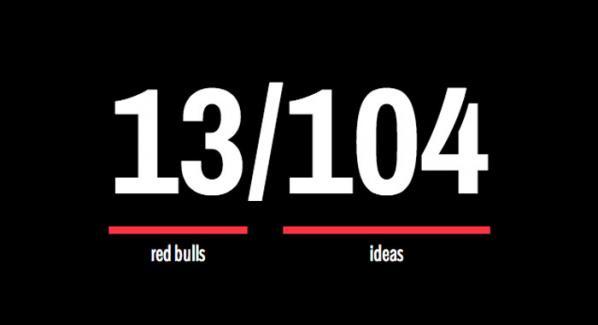
In Ryder Ripp’s “HyperCurrentLiving”, the artist collaborates with Red Bull in a month-long ‘performance’ where Ripps generates ideas and consumes the company’s energy drinks, updating these daily totals on a website. A live webcam allows the public to monitor his output: the artist sitting in front of a laptop in a self-designed karate suit emblazoned with both the Ripps and Red Bull graphic identities. The artist exemplifies the artist as cultural worker and in turn, the cultural worker as late capitalism agent par excellence.
A one-man advertising agency, Ripps engages in the type of ‘blue sky thinking’ prevalent across the communication sector, producing dematerialized commodities distributed virally via his Twitter feed. One concept (“a single serving site that tells you if you are being exploited at your internship”) cascades quickly after another (“an app that tells you if your gif is derivative or not”)9. Binge energy-drinking fuels this surge of productivity, shrugging off exhaustion and nutrition as inconvenient bodily constraints which drag down the bottom line.
On the face of it, this co-branding exercise between the artist and Red Bull, who spend 30-40% of their earnings on marketing10, seems like a productive synergy, a perfect collaboration. But Ryder is simply too much: by living out the brand (and wider contemporary) ideals to such an extent, an unspoken malaise is also laid bare. Aspirational traits lose their gleam: “connection” slides into technological incarceration, “busy” blurs into workaholic. While Ripps online persona remains vigilant through the night, his tweets static and steady, his disintegrating, hopped-up body quietly problematizes the ideal of the supercharged creative. By literally incarnating brand values, Ripps offers himself up as a sacrifice on the altar of hyper capitalism – a body incessantly creating and indefinitely deferring collapsing.

Julius von Bismarck operates within the logic of a different system: media and image production. People’s “great trust in their photographic reproductions of reality”11 motivated the development of the Image Fulgurator, an optically triggered projector which beams an image the instant it detects a camera flash. Essentially the device “lies in wait”12 for a member of the press to take a photo, infecting their snapshot with a text or image motif at the same moment it’s taken. If media is the “continuation of politics by other means”13, then the gun-like Fulgurator is part of the “new weaponry of information and communication technologies”14.
In one of von Bismarck’s best known works, he attended a speech by Barack Obama, projecting a white cross onto the podium and highlighting the “cult of personality” centred around the presidential candidate. Unlike post-editing techniques such as Photoshop, von Bismarck’s interventions insert themselves into the physical fabric of situations where power is performed and aura is staged: “NO” hovering above the Pope, an “O2” logo momentarily pinned on Berlin mayor Klaus Wowereit or a Magritte dove overlaying Mao Zedong’s portrait in Tiananmen Square.
The artist follows PR logic to it’s inevitable conclusion, where the immediate public becomes merely a prop in a mediated reality staged primarily for the press: sight lines and backdrops defined for a camera’s CCD chip. By operating within this temporary media space where the eye is largely superfluous, von Bismarck’s sub-second intervention is able to avoid detection while simultaneously rupturing an otherwise contiguous reality.
In many respects the so-called democratisation of news media has served the established providers – citizen journalists supplementing bare-bones media units and eyewitness smartphone footage winning back viewers for clicks and advertising revenue. Von Bismarck’s media interventions, however, take this phenomenon at face value, his images asserting their equal rights with any others. Decoupled from the copyright assertions of major media networks and distributed via Google spiders or social interactions, this “errant idea”15 becomes itinerant, taking its place alongside other “legitimate” imagery in search results and image banks.

Screenshot from Ed Fornieles’ “Dorm Daze”
Ed Fornieles’ “Dorm Daze” project stages its intervention in the social media sphere. The London-based artist invited his friends to participate in a 3 month “semi-scripted”16 performance on a self-contained network on Facebook. The participants scalped profiles from real American college students and enacted a series of fictional narratives centred around this formative period: a girl cheating on her first crush, a fraternity hazing gone wrong, the suicide of a good friend. The increased sophistication of social networks coupled with fluency in internet tools and tropes allowed the participants to employ a range of methodologies to advance the narrative: maps to establish location, comments on an upcoming event, live chats for personal encounters, or friends tagged in photos.
Like von Bismarck, Fornieles harnesses the goal of a system, extrapolating it to an extreme.
Here the identity tweaking carried out by every Facebook member – snapshots retouched and likes carefully distributed – is transformed into wholesale identity construction, preening becoming performance.
Participation is the currency of social networks, modeled by Facebook CEO Mark Zuckerberg himself, who had no qualms about setting most of his content to open and “didn’t see a need to limit visibility of pics with my friends, family”17. But while Fornieles downplays any subverting potential in the project, stating that it brought “committed users”18, these aren’t the users that the Facebook management, its new investors, or its advertisers are looking for. Fornieles has jettisoned the last shred of “authenticity” from the social media sphere, producing a group of profiles who can’t be monetized or monitored because of the simple fact that they don’t exist. Neither bots nor bodies, these ghost profiles LOLing their way through Facebook mock a billion dollar infrastructure, mining every connectivity tool in a purposeless play with a null result.
While this self contained durational performance was merely a speculative fiction, the feedback loop it initiates in the participant’s everyday existence is more persistent. Fornieles elaborates that the skills learnt “during this hypothetical three month exodus would be reapplied in conventional reality”19. For a generation brought up with avatars and profile pics, this practiced performativity sets the stage for a more permanent and personal “enhanced narrative”20, engendering an intervention IRL (in real life) which further blurs the “real/fictional binary”21.
On the face of it, Ripps, von Bismarck and Fornieles belong to an era of artists that may “no longer dream of an outside”22, their work utilizing the logic of branding and media to stage interventions that appear more collaborative than combative, preemptively disarming attempts at appropriation. But the lock-step engendered by this emulation inevitably fails. Accelerated by technology, betrayed by a body or liberated by the lack of one, this faltering may not disrupt the march of the inevitable so much as expose its inherent untenability.
Richard Stallman[1] the outspoken promoter for the Free Software movement, hates Facebook with a passion. He proposes that we should all leave Facebook and either find or build our own alternatives. The evidence offered by Stallman’s and the Electronic Frontier Foundation’s (EFF), who have been fighting for Internet freedoms since the 90s [2] shows how necessary it is that we understand and are more pro-active in managing the personal data that we give away through our online activities.
When we subscribe to Web 2.0 platforms such as Facebook we are at the mercy of the data brokers. These companies trade in people’s personal data; information which is aggregated by monitoring user actions and interactions across social media. This information can include “names, addresses, phone numbers, details of shopping habits, and personal data such as whether someone owns cats or is divorced.”[3] Fast moving developments in social media, make it difficult to keep up with the effects and consequences of these platforms. This is why the work of groups such as Commodify Inc. is so valuable. They bring imaginative and critical attention to the situation, sharing their knowledge of these daily networked complexities and correcting what they see as its negative effects.
Commodify Inc. is an artist-run Internet startup producing projects to help individuals capitalize on their online monetary potential. Their intention is to correct the imbalance of power in markets where users have no control over the transactions made with their personal data. They have completed various artistic projects and interventions on social media like, Fame Game, Give Me My Data, and Web 2.0 Suicide Machine. The co-founders are Birgit Bachler, Walter Langelaar, Owen Mundy, Tim Schwartz, with additional contributors Joelle Dietrick and Steven Alvarado.
Their new project Commodify.Us, was initiated when Owen Mundy and Tim Schwartz were invited by moddr_ to a residency in their lab in the summer of 2012 – when they were still a part of the WORM collective in Rotterdam. They worked on an initial idea that would succeed previous experiences of their already well-known and respected projects.
Commodify.Us is currently in beta phase. It promises to provide a platform for people to regain control over the commercial exploitation of their own personal data.
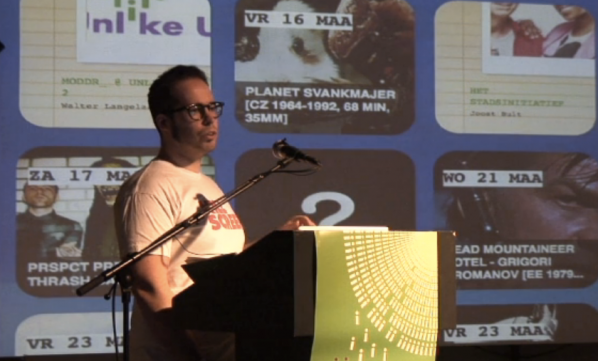
Intrigued by this project I contacted one of the co-founders, Walter Langelaar via email and asked him a few questions about this new platform.
Marc Garrett: Commodify.Us is for people to have greater control over their data. And it works when users export their data from social media websites and upload it to your platform. How will these users gain more control over their data and why is this important?
Walter Langelaar: Commodify.Us provides a platform for you to regain control over the commercial exploitation of your personal data. After exporting your profile data from social media websites and uploading the data to Commodify.Us, you can directly get in contact with interested buyers. On the importance for users I would say that it’s part raising awareness surrounding the monetization of profile data, and part creating a platform where people might work out and discuss how to do this themselves.
MG: It proposes to re-imagine the potential of relational data, creating a casting agency for virtual personas. I’m wondering what this may look like?
WL: We were too. In an early stage of the project we played with the idea that peoples’ various profiles could function like that within an agency; a client would ask for a specific set of qualities and/or characteristics within a set of profiles, and we could provide for this based on the uploads and their licensing options as set by the user. In the end we abandoned this idea for clarity.
MG: Commodify.Us offers people the opportunity to be part of an economy where interested buyers will pay to use the data supplied, unlike existing social media websites. How does this work?
WL: We are gearing up for a launch where the main goal will be to get a critical mass of around, a 1000 profiles. We anticipate that only with this kind of mass or volume will our initiative take hold with the potential buyers we have in mind, and the same goes for the more creative projects that could use the (open) data. Regarding the open profile data and otherwise licensed profiles that allow for reuse, we are researching the idea of ‘Fair Data’ (as in Fair Trade) and how to implement this as a profitable protocol for the end-user.

“Net activists construct tools whose intervention potential can be initiated by users under net conditions. These tools enable activists to develop new strategies in the data space of the Internet because they offer new means: New means afford new ends.”[4] (Dreher)
In his publication Networks Without a Cause: A Critique of Social Media, Geert Lovink lays down the gauntlet and asks us to “collectively unleash our critical capacities to influence technology design and workspaces, otherwise we will disappear into the cloud.” Anna Munster opens her excellent survey, Data Undermining: The Work of Networked Art in an Age of Imperceptibility, by saying “The more data multiplies both quantitatively and qualitatively, the more it requires something more than just visualisation. It also needs to be managed, regulated and interpreted into patterns that are comprehensible to humans.”[5] Commodify.Us goes one step further by allowing users to manage, regulate, repattern and reappropriate their own data using tools that share an essential functionality (if not purpose) with the power tools of Web 2.0.
Those previously seen as rebellious hacktivists are moving into new territories that deal with concepts of service. There has been a significant rise of artists exploring technology to influence mass Internet activity, against the domination of corporations who are data mining and tracking our on-line activities. Another example is TrackMeNot developed by Daniel Howe and Helen Nissenbaum. This is an extension created for the Firefox browser. “It hides users’ actual search trails in a cloud of ‘ghost’ queries, significantly increasing the difficulty of aggregating such data into accurate or identifying user profiles.”[6]
Howe and Nissenbaum mention they are aware their venture is not an immediate solution. However, the more we hear of and join these imaginative strategies “whereby individuals resist surveillance by taking advantage of blind spots inherent in large-scale systems” [7], and the more we adapt our behaviours to adopt these new ‘activist’ services, the more we demonstrate the demand for these new alternatives. And by so doing, we argue for the value of services that we can trust not to steal or manipulate our social contexts for financial and political gain.

A significant value offered by the Commodify.Us platform is the power to manage our own data. The simple act of downloading our own data from Facebook, and then uploading it to Commodify.Us supports us to rethink what all this information is. What once was just abstract data suddenly becomes material that we can manipulate. Alongside this realization arrives the understanding that this material was made by our interactions with all these platforms, and that other people are spying on us and making money out of it all. Once this data material is uploaded onto the Commodify.Us platform, it asks if we want this stuff to be a product under our own terms, or if we wish to make art out of it using their tools.
This is a cultural shift that demonstrates how contemporary Hacktivists are developing software that promises to offer realistic service infrastrucutures. When I interviewed Charlie Gere in 2012[8] he said that these artists “are not part of the restricted economy of exchange, profit, and return that is at the heart of capitalism, and to which everything else ends up being subordinated and subsumed. Thus they find an enclave away from total subsumption not outside of the market, but at its technical core.” For me, this kind of work is of central importance to the contemporary era, and it only occurs where artists cross over into territories where their knowledge of networks directly contributes to the building of alternative structures of social independence.
“At the dawn of the new millennium, Net users are developing a much more efficient and enjoyable way of working together: cyber-communism.” Richard Barbrook.
Dmytri Kleiner, author of The Telekommunist Manifesto, is a software developer who has been working on projects “that investigate the political economy of the Internet, and the ideal of workers’ self-organization of production as a form of class struggle.” Born in the USSR, Dmytri grew up in Toronto and now lives in Berlin. He is a founder of the Telekommunisten Collective, which provides Internet and telephone services, as well as undertakes artistic projects that explore the way communication technologies have social relations embedded within them, such as deadSwap (2009) and Thimbl (2010).
“Furtherfield recently received a hard copy of The Telekommunist Manifesto in the post. After reading the manifesto, it was obvious that it was pushing the debate further regarding networked, commons-based and collaborative endeavours. It is a call to action, challenging our social behaviours and how we work with property and the means of its production. Proposing alternative routes beyond the creative commons, and top-down forms of capitalism (networked and physical), with a Copyfarleft attitude and the Telekommunist’s own collective form of Venture Communism. Many digital art collectives are trying to find ways to maintain their ethical intentions in a world where so many are easily diverted by the powers that be, perhaps this conversation will offer some glimpse of how we can proceed with some sense of shared honour, in the maelstrom we call life…”
Marc Garrett: Why did you decide to create a hard copy of the Manifesto, and have it republished and distributed through the Institute of Networked Cultures, based in Amsterdam?
Dmytri Kleiner: Geert Lovink contacted me and offered to publish it, I accepted the offer. I find it quite convenient to read longer texts as physical copies.
MG: Who is the Manifesto written for?
DK: I consider my peers to be politically minded hackers and artists, especially artists whose work is engaged with technology and network cultures. Much of the themes and ideas in the Manifesto are derived from ongoing conversations in this community, and the Manifesto is a contribution to this dialogue.
MG: Since the Internet we have witnessed the rise of various networked communities who have explored individual and shared expressions. Many are linked, in opposition to the controlling mass systems put in place by corporations such as Facebook and MySpace. It is obvious that your shared venture critiques the hegemonies influencing our behaviours through the networked construct, via neoliberal appropriation, and its ever expansive surveillance strategies. In the Manifesto you say “In order to change society we must actively expand the scope of our commons, so that our independent communities of peers can be materially sustained and can resist the encroachments of capitalism.” What kind of alternatives do you see as ‘materially sustainable’?
DK: Currently none. Precisely because we only have immaterial wealth in common, and therefore the surplus value created as a result of the new platforms and relationships will always be captured by those who own scarce resources, either because they are physically scarce, or because they have been made scarce by laws such as those protecting patents and trademarks. To become sustainable, networked communities must possess a commons that includes the assets required for the material upkeep of themselves and their networks. Thus we must expand the scope of the commons to include such assets.
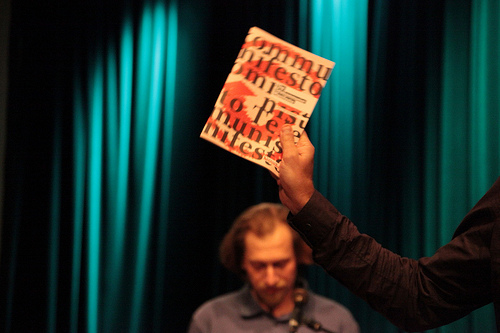
MG: The Manifesto re-opens the debate around the importance of class, and says “The condition of the working class in society is largely one of powerlessness and poverty; the condition of the working class on the Internet is no different.” Could you offer some examples of who this working class is using the Internet?
DK: I have a very classic notion of working class: Anyone whose livelihood depends on their continuing to work. Class is a relationship. Workers are a class who lack the independent means of production required for their own subsistence, and thus require wage, patronage or charity to survive.
MG: For personal and social reasons, I wish for the working class not to be simply presumed as marginalised or economically disadvantaged, but also engaged in situations of empowerment individually and collectively.
DK: Sure, the working class is a broad range of people. What they hold in common is a lack of significant ownership of productive assets. As a class, they are not able to accumulate surplus value. As you can see, there is little novelty in my notion of class.
MG: Engels reminded scholars of Marx after his death that, “All history must be studied afresh”[1]. Which working class individuals or groups do you see out there escaping from such classifications, in contemporary and networked culture?
DK: Individuals can always rise above their class. Many a dotCom founder have cashed-in with a multi-million-dollar “exit,” as have propertyless individuals in other fields. Broad class mobility has only gotten less likely. If you where born poor today you are less likely than ever to avoid dying poor, or avoid leaving your own children in poverty. That is the global condition.
I do not believe that class conditions can be escaped unless class is abolished. Even though it is possible to convince people that class conditions do not apply anymore by means of equivocation, and this is a common tactic of right wing political groups to degrade class consciousness. However, class conditions are a relationship. The power of classes varies over time, under differing historical conditions.
The condition of a class is the balance of its struggle against other classes. This balance is determined by its capacity for struggle. The commons is a component of our capacity, especially when it replaces assets we would otherwise have to pay Capitalist-owners for. If we can shift production from propriety productive assets to commons-based ones, we will also shift the balance of power among the classes, and thus will not escape, but rather change, our class conditions. But this shift is proportional to the economic value of the assets, thus this shift requires expanding the commons to include assets that have economic value, in other words, scarce assets that can capture rent.
MG: The Telekommunist Manifesto, proposes ‘Venture Communism’ as a new working model for peer production, saying that it “provides a structure for independent producers to share a common stock of productive assets, allowing forms of production formerly associated exclusively with the creation of immaterial value, such as free software, to be extended to the material sphere.” Apart from the obvious language of appropriation, from ‘Venture Capitalism’ to ‘Venture Communism’. How did this idea come about?
DK: The appropriation of the term is where it started.
The idea came about from the realization that everything we were doing in the free culture, free software & free networks communities was sustainable only when it served the interests of Capital, and thus didn’t have the emancipatory potential that myself and others saw in it. Capitalist financing meant that only capital could remain free, so free software was growing, but free culture was subject to a war on sharing and reuse, and free networks gave way to centralized platforms, censorship and surveillance. When I realized that this was due to the logic of profit capture, and precondition of Capital, I realized that an alternative was needed, a means of financing compatible with the emancipatory ideals that free communication held to me, a way of building communicative
infrastructure that was born and could remain free. I called this idea Venture Communism and set out to try to understand how it might work.
MG: An effective vehicle for the revolutionary workers’ struggle. There is also the proposition of a ‘Venture Commune’, as a firm. How would this work?
DK: The venture commune would work like a venture capital fund, financing commons-based ventures. The role of the commune is to allocate scarce property just like a network distributes immaterial property. It acquires funds by issuing securitized debt, like bonds, and acquires productive assets, making them available for rent to the enterprises it owns. The workers of the enterprises are themselves owners of the commune, and the collected rent is split evenly among them, this is in addition to whatever remuneration they receive for work with the enterprises.
This is just a sketch, and I don’t claim that the Venture Communist model is finished, or that even the ideas that I have about it now are final, it is an ongoing project and to the degree that it has any future, it will certainly evolve as it encounters reality, not to mention other people’s ideas and innovations.
The central point is that such a model is needed, the implementation details that I propose are… well, proposals.
MG: So, with the combination of free software, free code, Copyleft and Copyfarleft licenses, through peer production, does the collective or co-operative have ownership, like shares in a company?
DK: The model I currently support is that a commune owns many enterprises, each independent, so the commune would own 100% of the shares in each enterprise. The workers of the enterprises would themselves own the commune, so there would be shares in the commune, and each owner would have exactly one.
MG: In the Manifesto, there is a section titled ‘THE CREATIVE ANTI-COMMONS’, where the Creative Commons is discussed as an anti-commons, peddling a “capitalist logic of privatization under a deliberately misleading name.” To many, this is a controversy touching the very nature of many networked behaviours, whether they be liberal or radical minded. I am intrigued by the use of the word ‘privatization’. Many (including myself) assume it to mean a process whereby a non-profit organization is changed into a private venture, usually by governments, adding extra revenue to their own national budget through the dismantling of commonly used public services. Would you say that the Creative Commons, is acting in the same way but as an Internet based, networked corporation?
DK: As significant parts of the Manifesto is a remix of my previous texts, this phrase originally comes from the longer article “COPYRIGHT, COPYLEFT AND THE CREATIVE ANTI-COMMONS,” written by me and Joanne Richardson under the name “Ana Nimus”:
http://subsol.c3.hu/subsol_2/contributors0/nimustext.html
What we mean here is that the creative “commons” is privatized because the copyright is retained by the author, and only (in most cases) offered to the community under non-commercial terms. The original author has special rights while commons users have limited rights, specifically limited in such a way as to eliminate any possibility for them to make a living by employing this work. Thus these are not commons works, but rather private works. Only the original author has the right to employ the work commercially.
All previous conceptions of an intellectual or cultural commons, including anti-copyright and pre-copyright culture as well as the principles of free software movement where predicated on the concept of not allowing special rights for an original author, but rather insisting on the right for all to use and reuse in common. The non-commercial licenses represent a privatization of the idea of the commons and a reintroduction of the concept of a uniquely original artist with special private rights.
Further, as I consider all expressions to be extensions of previous perceptions, the “original” ideas that rights are being claimed on in this way are not original, but rather appropriated by the rights-claimed made by creative-commons licensers. More than just privatizing the concept and composition of the modern cultural commons, by asserting a unique author, the creative commons colonizes our common culture by asserting unique authorship over a growing body of works, actually expanding the scope of private culture rather than commons culture.
MG: So, this now brings us to Thimbl, a free, open source, distributed micro-blogging platform, which as you say is “similar to Twitter or identi.ca. However, Thimbl is a specialized web-based client for a User Information protocol called Finger. The Finger Protocol was orginally developed in the 1970s, and as such, is already supported by all existing server platforms.” Why create Thimbl? What kind of individuals and groups do you expect to use it, and how?
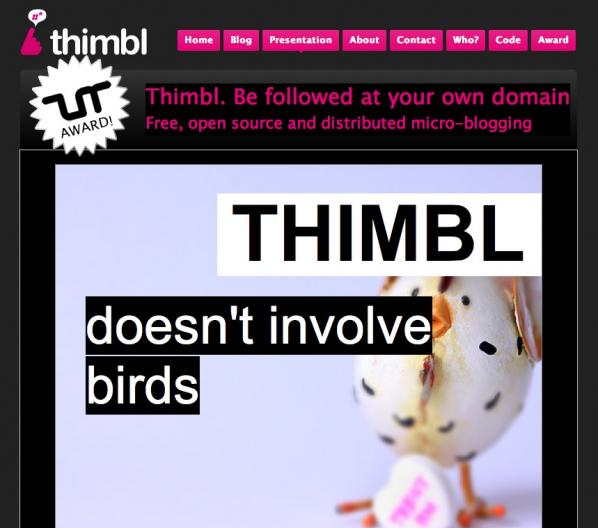
DK: First and foremost Thimbl is an artwork.
A central theme of Telekommunisten is that Capital will not fund free, distributed platforms, and instead funds centralized, privately owned platforms. Thimbl is in part a parody of supposedly innovative new technologies like twitter. By creating a twitter-like platform using Finger, Thimbl demonstrates that “status updates” where part of network culture back to the 1970s, and thus multimillion-dollar capital investment and massive central data centers are not required to enable such forms of communication, but rather are required to centrally control and profit from them.
MG: In a collaborative essay with Brian Wyrick, published on Mute Magazine ‘InfoEnclosure-2.0’, you both say “The mission of Web 2.0 is to destroy the P2P aspect of the Internet. To make you, your computer, and your Internet connection dependent on connecting to a centralised service that controls your ability to communicate. Web 2.0 is the ruin of free, peer-to-peer systems and the return of monolithic ‘online services’.”[2] Is Thimbl an example of the type of platform that will help to free-up things, in respect of domination by Web 2.0 corporations?
DK: Yes, Thimbl is not only a parody, it suggests a viable way forward, extending classic Internet platforms instead of engineering overly complex “full-stack” web applications. However, we also comment on why this road is not more commonly taken, because “The most significant challenge is not technical, it is political.” Our ability to sustain ourselves as developers requires us to serve our employers, who are more often than not funded by Capital and therefore are primarily interested in controlling user data and interaction, since delivering such control is a precondition of receiving capital in the first place.
If Thimbl is to become a viable platform, it will need to be adopted by a large community. Our small collective can only take the project so far. We are happy to advise any who are interested in how to join in. http://thimbl.tk is our own thimbl instance, it “knows” about most users I would imagine, since I personally follow all existing Thimbl users, as far as I know, thus you can see the state of the thimblsphere in the global timeline.
Even if the development of a platform like Thimbl is not terribly significant (with so much to accomplish so quickly), the value of a social platform is the of course derived from the size of it’s user base, thus organizations with more reach than Telekommunisten will need to adopt the platform and contribute to it for it to transcend being an artwork to being a platform.
Of course, as the website says “the idea of Thimbl is more important than Thimbl itself,” we would be equally happy if another free, open platform extending classic Internet protocols where to emerge, people have suggested employing smtp/nntp, xmmp or even http/WebDav instead of finger, and there are certain advantages and disadvantages to each approach. Our interest is the development of a free, open platform, however it works, and Thimbl is an artistic, technical and conceptual contribution to this undertaking.
MG: Another project is the Telekommunisten Facebook page, you have nearly 3000 fans on there. It highlights the complexity and contradictions many independents are faced with. It feels as though the Internet is now controlled by a series of main hubs; similar to a neighbourhood being dominated by massive superstores, whilst smaller independent shops and areas are pushed aside. With this in mind, how do you deal with these contradictions?
DK: I avoided using Facebook and similar for quite some time, sticking to email, usenet, and irc as I have since the 90s. When I co-authored InfoEnclosure 2.0, I was still not a user of these platforms. However it became more and more evident that not only where people adopting these platforms, but that they were developing a preference for receiving information on them, they would rather be contacted there than by way of email, for instance. Posting stuff of Facebook engaged them, while receiving email for many people has become a bother. The reasons for this are themselves interesting, and begin with the fact that millions where being spent by Capitalists to improve the usability of these platforms, while the classic Internet platforms were more or less left as they were in the 90s. Also, many people are using social media that never had been participants in the sorts of mailing lists, usenet groups, etc that I was accustomed to using to share information.
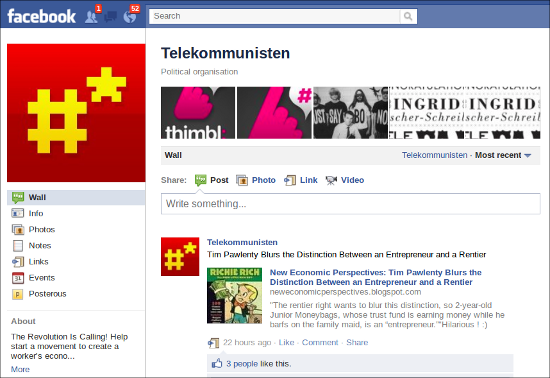
If I wanted to reach people and share information, I needed to do so on the technologies that others are using, which are not necessarily the ones I would prefer they use.
My criticism of Facebook and other sites is not they are not useful, it is rather that they are private, centralized, proprietary platforms. Also, simply abstaining from Facebook in the name of my own media purity is not something that I’m interested in, I don’t see capitalism as a consumer choice, I’m more interested in the condition of the masses, than my own consumer correctness. In the end it’s clear that criticizing platforms like Facebook today means using those platforms. Thus, I became a user and set up the Telekommunisten page. Unsurprisingly, it’s been quite successful for us, and reaches a lot more people than our other channels, such as our websites, mailing lists, etc. Hopefully it will also help us promote new decentralized channels as well, as they become viable.
MG: So, I downloaded deadSwap (http://deadSwap.net) which I intend to explore and use. On the site it says “The Internet is dead. In order to evade the flying monkeys of capitalist control, peer communication can only abandon the Internet for the dark alleys of covert operations. Peer-to-peer is now driven offline and can only survive in clandestine cells.” Could you explain the project? And are people using it as we speak?
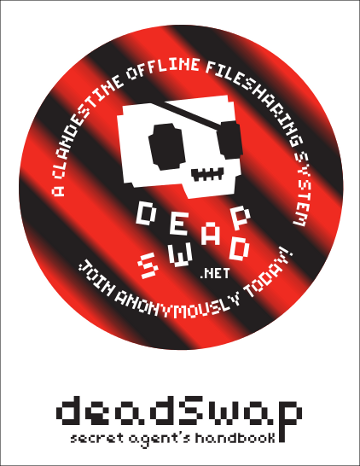
DK: I have no idea if people are using it, I am currently not running a network.
Like thimbl, deadSwap is an artwork. Unlike thimbl, which has the seeds of a viable platform within it, deadSwap is pure parody.
It was developed for the 2009 Sousveillance Conference, The Art of Inverse Surveillance, at Aarhus University. deadSwap is a distopian urban game where participants play secret agents sharing information on usb memory sticks by hiding them in secret locations or otherwise covertly exchanging them, communicating through an anonymizing SMS gateway. It is a parody of the “hacker elite” reaction to Internet enclosure, the promotion of the idea that new covert technologies will defeat attempts to censor the Internet, and we can simply outsmart and outmaneuver those who own and control our communications systems with clandestine technologies. This approach often rejects any class analysis out-of-hand, firmly believing in the power of us hackers to overcome state and corporate repressions. Though very simple in principal, deadSwap is actually very hard to use, as the handbook says “The success of the network depends on the competence and diligence of the participants” and “Becoming a super-spy isn’t easy.”
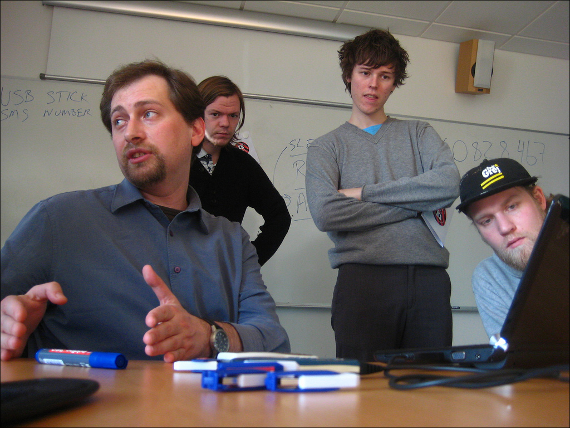
MG: What other services/platforms/projects does the Telekommunisten collective offer the explorative and imaginative, social hacker to join and collaborate with?
DK: We provide hosting services which are used by individuals and small organizations, especially by artists, http://trick.ca, electronic newsletter hosting (http://www.freshsent.info) and a long distance calling service (http://www.dialstation.com). We can often be found on IRC in#telnik in freenode. Thimbl will probably be a major focus for us, and anybody that wants to join the project is more than welcome, we have a community board to co-ordinate this which can be found here: http://www.thimbl.net/community.html
For those that want to follow my personal updates but don’t want don’t use any social media, most of my updates also go here: http://dmytri.info
Thank you for a fascintaing conversation Dmytri,
Thank you Marc 🙂
=============================<snip>
Top Quote: THE::CYBER.COM/MUNIST::MANIFESTO by Richard Barbrook. http://www.imaginaryfutures.net/2007/04/18/by-richard-barbrook/
The Foundation for P2P Alternatives proposes to be a meeting place for those who can broadly agree with the following propositions, which are also argued in the essay or book in progress, P2P and Human Evolution. http://blog.p2pfoundation.net
In the essay ‘Imagine there is no copyright and no cultural conglomerates too…” by Joost Smiers and Marieke van Schijndel, they say “Once a work has appeared or been played, then we should have the right to change it, in other words to respond, to remix, and not only so many years after the event that the copyright has expired. The democratic debate, including on the cutting edge of artistic forms of expression, should take place here and now and not once it has lost it relevance.”
Issue no. 4 Joost Smiers & Marieke van Schijndel, Imagine there are is no copyright and no cultural conglomorates too… Better for artists, diversity and the economy / an essay. colophon: Authors: Joost Smiers and Marieke van Schijndel, Translation from Dutch: Rosalind Buck, Design: Katja van Stiphout. Printer: ‘Print on Demand’. Publisher: Institute of Network Cultures, Amsterdam 2009. ISBN: 978-90-78146-09-4.
http://networkcultures.org/wpmu/theoryondemand/titles/no04-imagine-there-are-is-no-copyright-and-no-cultural-conglomorates-too/
Liz Filardi is a New York City-based performance artist who often works in public space. She was recently awarded a Turbulence Commission for a networked performance piece called I’m Not Stalking You; I’m Socializing, exploring the anxieties of social networking in three modules. “Status Grabber,” the first module, is a satirical online service that extends the status update phenomenon to participation over the telephone. “Black & White,” the second module, is a Facebook-like website, consisting of two interlinked profiles, that tells the story behind one of the original cases of criminal stalking in America. “Facetbook,” the final module, is a performance piece in which the artist compiles a series of archives of her live Facebook profile to illustrate the tension of online identity– between the façade of a profile and the more telling story of how the profile changes over time. The interview was conducted by Taina Bucher, PhD fellow in the Department of Media and Communication at the University of Oslo, Norway. Bucher and Filardi met in Greenwich Village, New York City in May, 2010.
Taina Bucher: How prominently do your friends feature in your work?
Liz Filardi: Well, my only “in” to a social network like Facebook is my own profile, my own network. I think I have about 900 friends. I could start over with a new profile, but I would still only be able to access people that I know or know of. So the people who participate in works based in existing networks, like “Facetbook,” are my friends, and in this context, that includes any Facebook “friend” who feels comfortable commenting or interacting with me. I suppose there is also a subset of “friends” who are made aware of my activity without necessarily caring or wanting to interact with me. In that respect, networked performance on Facebook is very much like performing in public space—I get ignored a lot.
But I would love to find a way to reach a completely different audience on a social network, ideally a subset of users who have stumbled upon my profile without really knowing me or maybe only knowing me from the context of the network because I’m a “friend” of someone who they have “friended.” I have been thinking about starting over on a network like Facebook with this goal in mind, just to see what is possible. It would also be fun to create a new profile controlled by a collective of artists who want to play and experiment.
Why not just make a group on Facebook?
Groups have limitations. Individuals have the most access and mobility on Facebook, because it is designed with the individual’s activity in mind. Groups are like, “I’m here, come over here,” while individuals can say, “I like this, I am doing this, you and I are friends,” which is obviously what drives the site. I am also more compelled by putting a face on a group and speaking from the first person, mixing individual voices and sensibilities and presenting that as one person. It feels a little more subversive. I am interested in playing with the expectations of “friends” on Facebook. For some reason, there is a lot of trust that everyone, that is every non-celebrity, is exactly who they say they are.
Can you tell us a little about your project “Status Grabber?”
“Status Grabber” was created as a satire on the obsession with status updates. I wanted to know how people would react to a telephone-based service that essentially mimicked the way people use Twitter. So I called people and told them that someone they knew had anonymously requested a status update, and that they should provide me with a brief statement that I could post to the internet. I set up a website where people could actually make those requests and hear the responses. But I also made cold calls to random people listed in the telephone book.

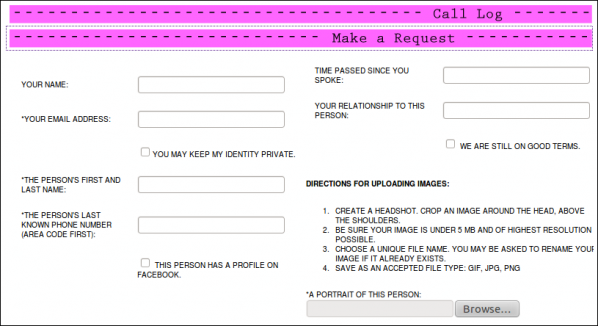
My interest in status updates lies in the disconnect between the author’s intention and the follower’s intention as they engaged in a fairly consistent relationship mediated by a service like Twitter. On Twitter, you can post one message immediately visible to your followers, and those people can discover something about you and experience the feeling of a connection without ever having to say a word or reciprocate. In fact, as you post your update, you often do so with a vague idea of audience, not necessarily of personal connection. So the relationship between a Twitter author and follower can feel smug, but it is artificial—it is a designed experience. Apparently, if popular social tools fill a vacuum of desire, as we often believe, people actually prefer this designed experience on some level. We tend to prioritize the feeling of a connection over the actual value of the connection. In making the calls for “Status Grabber,” I’m basically confronting people with this cultural value.
I visited the site and listened to the call records you posted. It seems that people don’t have a clue about the notion of status updates.
Yeah, the concept of a status update obviously doesn’t translate to the telephone. On the phone, there is much more opportunity to communicate beyond the 140 characters allowed in a Twitter status update, so that became a humorous limitation to the updates that people were encouraged to provide. As a totally believable service, Status Grabber suggests that people actually do not want to have a full conversation or hear a complete update on your status, but instead prefer the abridged version so they can get on with their lives. Of course, most of the call recipients seemed slightly disappointed or appalled for that reason, and in that way, it felt like a good prank phone call.
Call recipients that were willing to participate seemed to feel anxious about the pressure of submitting a status update verbally. They were on the spot to say something substantial or witty as if posting to their Twitter or Facebook account. Most of the updates reflect more spontaneity, less density than can be read in Twitter feeds. I often felt that I was invading their privacy to demand a status update by telephone.
Let us jump to your third module “Facetbook.” How did you come up with the idea?
My day job is in design and I work with the content management system and blog software WordPress. When you edit a blog entry, a new entry is simply added to the database like an appendix to the original entry, so that you’re never editing the existing content of the database but merely adding to it. There is an archive of all your revisions. I started to imagine Facebook having a similar structure. It is possible that we are creating an archive of our life just by being active users, and yet, we have no ownership or access to it. Meanwhile, we present a singular identity within the construct of the profile. We update our profiles to project an idealized representation of ourselves. But if anyone could see the archive of these profiles and be privy to how they have evolved over the years, they would get a much more accurate sense of who we are, and maybe they would be able to see that truth far more clearly than we ourselves can see it.
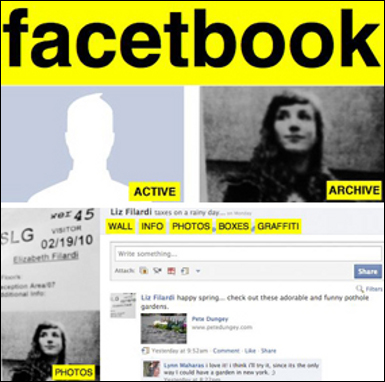
With that in mind, I started to imagine that Facebook actually provides a literal construct of identity. Is this why it’s so addictive and popular? It’s not as if we can go back in time in real life and see written archives of every conversation we have had with friends, and every song we quoted in high school, and every trend we followed. We understand our own identities based on our memories and the occasional ephemera- diaries, photographs, videos, concert tickets, old clothes. In some senses, we don’t own our past, but only the precious ephemera. And in the space between the ephemera and reality, we get to imagine our own story. On Facebook, we can flip back through our activity and photos, and we construct our profiles based on how we see ourselves and who we would like to be. But we can never see old profiles, ones that we’ve since replaced, or content that we’ve removed. We get to curate our identity, manage the expectations of “friends” and find privacy by hiding behind the content we chose to share. That feels real.
And yet, there is something distinctly unreal about Facebook, which is that it is essentially a document, a record in and of itself. Facebook users live on a document. What if everything ever deleted, in fact, lived on? That makes me anxious. So I started looking for software that would allow me to archive my Facebook profile, and I found an experimental Firefox plugin developed by a group of computer scientists at Old Dominion and Harding University. Using their plugin, I started to archive my profile every time I wanted to change it. I wanted to see what it would be like to own an archive—to at least know what it would contain, even if I couldn’t control what Facebook did with my content.
The truth was that I was far more invested in my image and my Facebook life when I was in college than I am today. Maybe it would have been more insightful to capture that early period. But ultimately, the “Facetbook” performance became about investing in Facebook again and thinking about the stakes of participation. Knowing that I would be creating this archive and could delete my profile at any time, I tried to confront the extent of how people actually use Facebook. I wrote things like, “For brief periods of time, I have favorite profiles that I like to check,” and “even if you never change your profile, I will look at the same three pictures more than once. It gives my mind something to work with.” It feels strange to perform on a site where only a very acute mix of authenticity and performance is acceptable as a voice—you know, in posting status updates that display some charming aspect of yourself without exposing that you’ve given any thought to it. With “Facetbook,” I’m trying to expose Facebook as a site that serves a more libidinal function for people.
How do you see performance art changing in an environment where performance has, to some degree, become commonplace?
That’s a bold statement—one could argue that public life has always been about performance and that performance is no more commonplace today than in the past—but maybe it is more commonplace. The prominence of the social web—especially for younger generations who have restricted access in the real world—pushes public life online and into the realm of performance. People who are growing up with social networks are justifiably feeling like the center of the world with daily evidence to that effect. The lives of prominent, young YouTube vloggers are filled with connections to near strangers who make up coveted audiences across geographic boundaries. Any time someone has an audience, they become a performer. I think of Natalie Bookchin’s Testament, which is a multi-channel video essay that appropriates YouTube vlogs to speak to themes like work, economy, and war. The video diaries that are used in her piece exemplify a personal, confessional approach as seen in television shows like The Real World, and yet they are beyond television—these people are acutely aware that they are sharing their daily life not necessarily with friends but with an audience. The vloggers use common buzzwords and phrases that Bookchin pulls out to create the sensation that they are speaking in unison, just as news anchors and talk show hosts speak in an established language and tone. And that has become a normative way to socialize.
But performance art is entirely different from the spirit of performance on the social web. For one thing, the moment you disseminate over the internet or design your work for an internet based reception, you are creating media art, or networked performance, as Turbulence has preferred to call it. As far as my own experience with performance art, every time I perform something in public, I imagine being interpreted in two camps: an amateur throwback to the founding artists like Abramovic and Ono and Shneemann (young performance artists always seem so nostalgic for the power of the body and the live act, but it’s rare to pull off something powerful and new) and/or an urban prankster looking for attention in the local paper or city blog (a la the clever performance troupes like Improv Everywhere who disrupt city life with the exciting treat of surrealism). So I think the challenge for contemporary performance art is to find a place that is at once culturally relevant and striking, and to champion public space in a compelling way. It’s too easy to just take your actions to the streets of New York like plop art. People are already used to that. Lately I’ve been trying to create works that don’t come across as one-liners, but instead inspire the viewer to question what is going on, or to hold on to one particularly poignant affect or visual. The last thing I want to say—it gets problematic when one begins to qualify performance art as something that happens in galleries and museums because it was meant to defy the commodification of art, but I do want to say that I see it forging ahead in small galleries like Recess in SoHo.
Can you speak a little about your second module, “Black & White?” How did that come about?
That project started with research into the history of criminal stalking, as it relates to the popular contemporary idea of “Facebook stalking.” I wanted to explore the relationship between the tongue and cheek use of the word stalking to describe fairly typical activity on social networks and historical accounts of serious stalking in a time less saturated by social web technologies. I was fascinated by a famous case from 1988 between two co-workers at a Silicon Valley software engineering company. A young woman, a 22 or 23 years old Laura Black, started working at the company as one of the few female engineers. She sparked the unhealthy interest of a male engineer, Richard Farley, who became suddenly deeply obsessed with her. He stalked her for years, and while she sought help at her company when she feared for her life, she had trouble getting any real protection. She changed addresses and phone numbers, which only provided temporary relief, and got a temporary, ineffective restraining order. He would send letters, arrive at her house unannounced, and once joined her gym. In her anger and fear, it seems that she also wanted to show him that he couldn’t control her and that she was still going to enjoy her life and stay in the area. So there really wasn’t a collective intelligence about the threat of stalking at the time. Farley eventually arrived at the office with an arsenal of weapons and attacked the entire company. Black was shot in the shoulder and survived. Farley was arrested. Shortly after, the first anti-stalking law passed in California in 1989 and the story, along with a couple of other violent stalking cases, made national news.
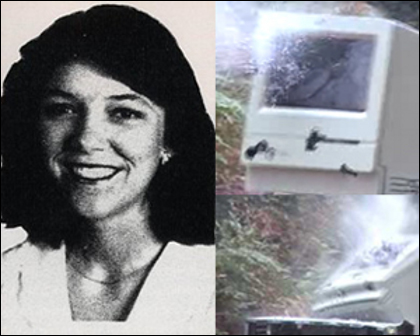
Today, we don’t hear about cases like that because we have a lot more information and legislation to prevent that kind of thing. I can only assume that potential incidents are resolved before escalating to that level. We live in a different climate, where we share a lot more information about ourselves on the social web, and “stalking” is a hyperbolic term that describes the ultimately harmless activity of focusing on the available information of a single person without their knowledge or consent. The use of negative hyperbolic terms like “stalking” indicates a safer cultural climate, but also a latent guilt that may be rooted in cases such as the one illustrated in “Black & White.”
This makes me think of Twitter and the term “followers.”
Yes, it’s similar. Perhaps there’s a greater cultural need to be leader, with a collection of commoditized “followers” in tow. On the social web, we are less often ordinary humans and more often celebrities or actors splintered by various interests and audiences.
In “Black & White,” why do you transpose the stalking case into the paradigm of a social network?
Black&White is the name of a fictional network that looks much like Facebook, but it only contains two members: Laura Black and Richard Farley. Creating this site was a way to call attention to collective intelligence, to speak the language that we (on Facebook) have all learned so well. I knew that most people would intuitively be able to navigate the format and learn the story between the two people involved. In the context of the vast network of Facebook, it is striking that there are only two people in this network. Their content is linked through their job and location, despite their apparent lack of friendship. Underneath the relatively unassuming public profiles is a horrifying, one-sided correspondence in their message in- and outboxes. I wanted to dramatize their loneliness and emphasize the lack of will in their connection, which is how they will be remembered in the American collective consciousness. Hopefully this leads viewers to consider how and why the term “stalking” or the act of “stalking” has changed since the 1980s.
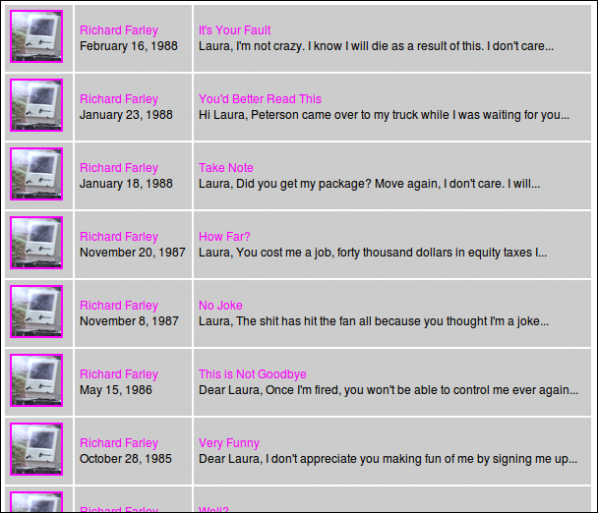
In terms of creativity on social networks, I think a lot of us are just filling in forms. The template of the social network is limiting. Will this have any affect on the direction of your work?
That’s a good question. I have felt confined by the structure of social networks, and even with the content of art that speaks directly to social networks. With I’m Not Stalking You; I’m Socializing, I started with the easiest form of art made to respond to social networks: a satire perpetrated through mimicry in other medias or dimensions, as seen in “Status Grabber.” This has been done in other works, as well. I guess I needed to make that piece so that I could see what was beyond it, and I believe I went a little further and yielded more insight in the other two modules. But now I’m starting to see how the social web simply permeates our consciousness and I believe I may find more insight if I take a step back from art on social networks altogether. As someone who has grown up on social networks, I’m interested to see how the themes that I’ve honed in my work with social networks will surface and return in works and areas of practice that move in a new direction.